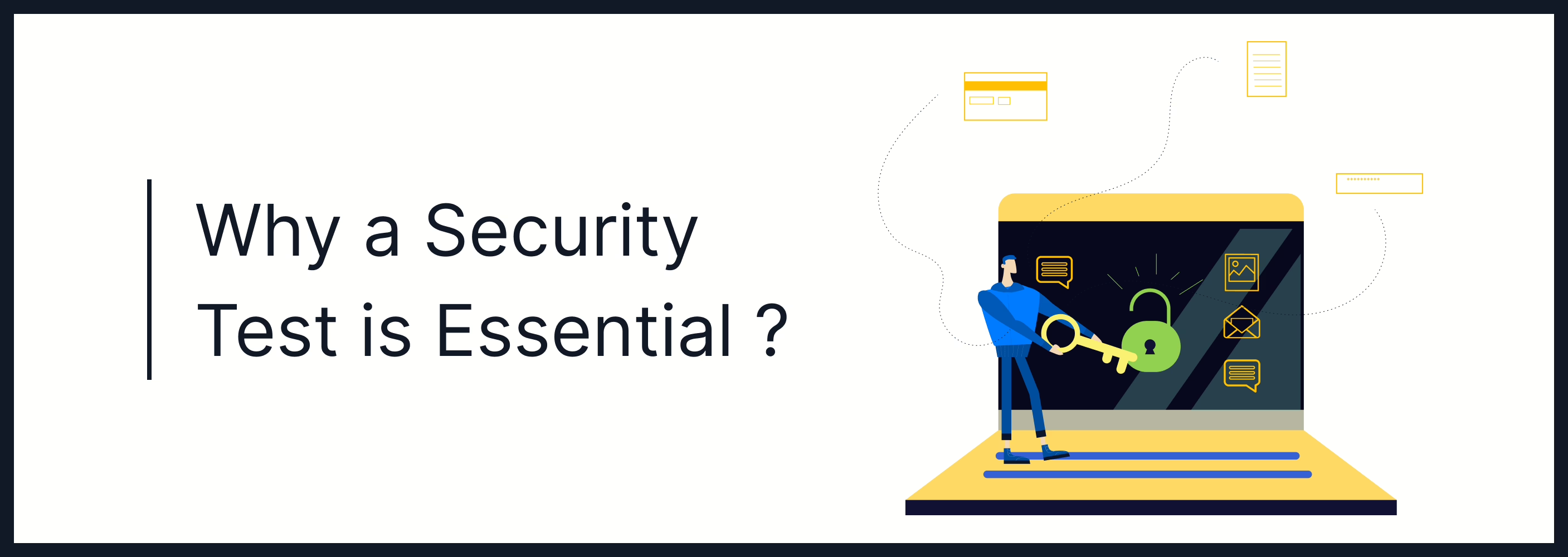
Oct 15, 2024 Information hub
Why a Security Test is Essential for Protecting Your Business
In today’s hyper-connected world, where businesses and individuals rely heavily on digital platforms, the importance of cybersecurity cannot be overstated. With the increasing sophistication of cyber threats, organizations must take proactive measures to safeguard their systems, data, and users. One of the most effective ways to do this is through security testing. A security test is a process designed to identify vulnerabilities, weaknesses, and potential threats in a system, application, or network. By conducting regular security tests, organizations can detect and address security flaws before malicious actors exploit them. This blog post will delve into the significance of security testing, its relevance in today’s digital landscape, and the various methods and tools used to ensure robust protection.
The Relevance of Security Testing Today
The Growing Threat Landscape
The digital world is evolving rapidly, and with it, the threat landscape is becoming more complex. Cybercriminals are constantly developing new tactics to breach systems, steal sensitive data, and disrupt operations. According to a report by Cybersecurity Ventures, cybercrime is expected to cost the world $10.5 trillion annually by 2025, up from $3 trillion in 2015. This staggering statistic highlights the urgent need for organizations to prioritize cybersecurity & security testing.
Security testing plays a crucial role in this context. It helps organizations stay ahead of cybercriminals by identifying vulnerabilities before they can be exploited. Whether it’s a small business or a large enterprise, no organization is immune to cyber threats. Therefore, conducting regular security tests is essential to ensure the safety and integrity of digital assets.
Regulatory Compliance
In addition to the growing threat landscape, regulatory compliance is another reason why security testing is more relevant than ever. Governments and regulatory bodies worldwide have introduced stringent data protection laws, such as the General Data Protection Regulation (GDPR) in Europe and the California Consumer Privacy Act (CCPA) in the United States. These regulations require organizations to implement robust security measures to protect personal data.
Failure to comply with these regulations can result in hefty fines and reputational damage. Security testing helps organizations meet these compliance requirements by ensuring that their systems are secure and that they have the necessary safeguards in place to protect sensitive data.
Types of Security Test
Security testing is not a one-size-fits-all approach. There are various types of security tests, each designed to address specific aspects of a system’s security. Below are some of the most common types of security tests:
1. Vulnerability Scanning
Vulnerability scanning is an automated process that identifies known vulnerabilities in a system, application, or network. It involves using specialized tools to scan for weaknesses, such as outdated software, misconfigurations, or missing patches. Vulnerability scanning is typically the first step in a security test, as it provides a high-level overview of potential security issues.
Benefits of Vulnerability Scanning:
- Automated and Efficient: Vulnerability scanning tools can quickly scan large systems and networks, making it an efficient way to identify vulnerabilities.
- Comprehensive: These tools can detect a wide range of vulnerabilities, from software bugs to configuration issues.
- Cost-Effective: Since vulnerability scanning is automated, it is a cost-effective way to identify security issues without requiring extensive manual effort.
2. Penetration Testing (Pen Testing)
Penetration testing, or pen testing, is a more in-depth security test that involves simulating real-world attacks on a system or network. Unlike vulnerability scanning, which is automated, pen testing is typically performed by security experts who attempt to exploit vulnerabilities to gain unauthorized access to a system. The goal of pen testing is to identify weaknesses that could be exploited by attackers and to assess the effectiveness of existing security measures.
Types of Penetration Testing:
- Black Box Testing: The tester has no prior knowledge of the system and attempts to breach it as an external attacker would.
- White Box Testing: The tester has full knowledge of the system, including access to source code and architecture, and tests for vulnerabilities from an insider’s perspective.
- Gray Box Testing: The tester has partial knowledge of the system and tests for vulnerabilities from both an external and internal perspective.
Benefits of Penetration Testing:
- Realistic Attack Simulation: Pen testing provides a realistic assessment of how an attacker might exploit vulnerabilities in a system.
- Identifies Complex Vulnerabilities: Unlike automated tools, pen testers can identify complex vulnerabilities that may not be detected by vulnerability scanners.
- Improves Incident Response: Pen testing helps organizations improve their incident response capabilities by simulating real-world attacks.
3. Security Audits
A security audit is a comprehensive review of an organization’s security policies, procedures, and controls. It involves evaluating the effectiveness of security measures and ensuring that they align with industry standards and regulatory requirements. Security audits can be conducted internally or by third-party auditors.
Benefits of Security Audits:
- Ensures Compliance: Security audits help organizations ensure that they comply with regulatory requirements and industry standards.
- Identifies Gaps in Security Policies: Audits can identify gaps in security policies and procedures that may leave an organization vulnerable to attacks.
- Improves Security Posture: By identifying weaknesses in security controls, audits help organizations improve their overall security posture.
4. Ethical Hacking
Ethical hacking involves hiring security professionals, known as ethical hackers or white-hat hackers, to test the security of a system by attempting to breach it. Ethical hackers use the same techniques as malicious hackers but with the organization’s permission and for the purpose of improving security.
Benefits of Ethical Hacking:
- Proactive Security: Ethical hacking allows organizations to identify and fix vulnerabilities before they can be exploited by malicious actors.
- Expertise: Ethical hackers are highly skilled professionals who can identify vulnerabilities that may be missed by automated tools or less experienced testers.
- Customized Testing: Ethical hackers can tailor their testing to the specific needs and risks of an organization.
5. Security Code Review
A security code review involves analyzing the source code of an application to identify security vulnerabilities. This type of security test is typically performed during the development phase to ensure that security is built into the application from the ground up.
Benefits of Security Code Review:
- Early Detection of Vulnerabilities: By reviewing code during the development phase, organizations can identify and fix vulnerabilities before the application is deployed.
- Improves Code Quality: Security code reviews not only identify security vulnerabilities but also improve the overall quality of the code.
- Reduces Costs: Fixing security issues during development is much more cost-effective than addressing them after the application has been deployed.
Current Trends in Security Testing
As the cybersecurity landscape continues to evolve, so do the methods and tools used for security testing. Below are some of the current trends shaping the future of security testing:
1. Automation and AI in Security Test
Automation is playing an increasingly important role in security testing. Automated tools can quickly scan systems and networks for vulnerabilities, reducing the time and effort required for manual testing. Additionally, artificial intelligence (AI) and machine learning (ML) are being integrated into security testing tools to improve their accuracy and effectiveness.
AI-powered security testing tools can analyze vast amounts of data to identify patterns and anomalies that may indicate a security threat. These tools can also learn from past attacks and adapt to new threats, making them more effective at detecting and preventing cyberattacks.
2. Shift-Left Security Testing
The concept of shift-left security involves integrating security testing earlier in the software development lifecycle (SDLC). Traditionally, security testing was performed at the end of the development process, but this approach often led to delays and increased costs. By shifting security testing to the left, organizations can identify and fix vulnerabilities during the development phase, reducing the risk of security issues in the final product.
3. Cloud Security Testing
As more organizations move their operations to the cloud, cloud security testing has become a critical component of cybersecurity. Cloud environments present unique security challenges, such as misconfigurations, data breaches, and unauthorized access. Security testing tools and techniques are being adapted to address these challenges and ensure the security of cloud-based systems and applications.
4. DevSecOps
DevSecOps is a practice that integrates security into the DevOps process. It emphasizes collaboration between development, operations, and security teams to ensure that security is a priority throughout the software development lifecycle. Security testing is a key component of DevSecOps, as it allows organizations to identify and address security issues early in the development process.
Challenges in Security Testing
While security testing is essential for protecting systems and data, it is not without its challenges. Some of the common challenges organizations face when conducting security tests include:
1. Evolving Threats
Cyber threats are constantly evolving, and new vulnerabilities are discovered regularly. Keeping up with the latest threats and ensuring that security tests are up to date can be a daunting task for organizations.
2. Limited Resources
Many organizations, especially small and medium-sized businesses, may lack the resources to conduct comprehensive security tests. Security testing requires specialized tools and expertise, which can be costly and time-consuming.
3. False Positives
Automated security testing tools can sometimes generate false positives, which are vulnerabilities that are flagged as security issues but are not actually exploitable. False positives can lead to wasted time and effort, as security teams may spend valuable resources addressing non-existent threats.
4. Balancing Security and Usability
Security testing can sometimes result in recommendations that improve security but negatively impact the usability of a system or application. Organizations must strike a balance between implementing strong security measures and ensuring that their systems remain user-friendly.
Benefits of Security Testing
Despite the challenges, the benefits of security testing far outweigh the drawbacks. Some of the key benefits of security testing include:
- Improved Security Posture: Security testing helps organizations identify and address vulnerabilities, improving their overall security posture.
- Reduced Risk of Cyberattacks: By identifying and fixing vulnerabilities, security testing reduces the risk of cyberattacks and data breaches.
- Compliance with Regulations: Security testing helps organizations comply with data protection regulations and industry standards.
- Cost Savings: Identifying and fixing security issues early in the development process can save organizations significant costs in the long run.
- Increased Customer Trust: Organizations that prioritize security testing demonstrate their commitment to protecting customer data, which can enhance customer trust and loyalty.
Conclusion
In an era where cyber threats are becoming more sophisticated and prevalent, security testing is no longer optional—it’s a necessity. By conducting regular security tests, organizations can identify vulnerabilities, improve their security posture, and reduce the risk of cyberattacks. Whether it’s vulnerability scanning, penetration testing, or security audits, each type of security test plays a crucial role in ensuring the safety and integrity of digital systems.
As the cybersecurity landscape continues to evolve, organizations must stay ahead of the curve by adopting the latest trends and technologies in security testing. Automation, AI, and DevSecOps are just a few of the innovations shaping the future of security testing. By embracing these trends and addressing the challenges of security testing, organizations can build a robust defense against the ever-growing threat of cybercrime.
Actionable Takeaways:
- Conduct regular security tests to identify and address vulnerabilities.
- Stay up to date with the latest cybersecurity threats and trends.
- Integrate security testing into the software development lifecycle (shift-left security).
- Consider adopting automated and AI-powered security testing tools.
- Ensure compliance with data protection regulations through security audits.
By prioritizing security testing, organizations can protect their systems, data, and users from the growing threat of cyberattacks and ensure long-term success in the digital age.
